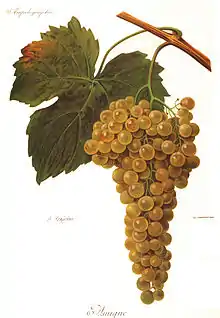Amigne
Amigne is a white Swiss wine grape[1] planted primarily in the Valais region, with most of the plantations in Vetroz. Total Swiss plantations of the variety in 2009 stood at 43 hectares (110 acres).[2]
| Amigne | |
|---|---|
| Grape (Vitis) | |
 Amigne in L'Ampélographie (Viala and Vermorel) | |
| Color of berry skin | Blanc |
| Species | Vitis vinifera |
| Also called | Amigne Blanche, Amique |
| Origin | Switzerland |
| Notable regions | Valais |
| VIVC number | 425 |
The grape can make rich, full bodied wines. Dry Amigne wines are powerful with linden aromas, and it is also used for sweet dried grape wines (flétri), which tend to have citrus fruit and bitter almond aromas.[3]
DNA profiling at UC Davis has indicated a parent-offspring relationship between Amigne and Petit Meslier, which was unexpected from a classical ampelographic point of view.[3] (It was previously believed to be related to Petite Arvine.[4])
Synonyms
Amigne is also known under the synonyms Amigne Blanche and Amique.[1]
References
- Amigne Archived 2011-07-19 at the Wayback Machine, Vitis International Variety Catalogue, accessed on June 19, 2010
- Office fédéral de l’agriculture OFAG: Das Weinjahr 2009 / L'année d'viticole 2009 Archived 2011-07-07 at the Wayback Machine
- Jancis Robinson, ed. (2006). "Amigne". Oxford Companion to Wine (Third ed.). Oxford: Oxford University Press. p. 20. ISBN 0-19-860990-6.
- J. Robinson Jancis Robinson's Wine Course Third Edition pg 100 Abbeville Press 2003 ISBN 0-7892-0883-0
This article is issued from Wikipedia. The text is licensed under Creative Commons - Attribution - Sharealike. Additional terms may apply for the media files.